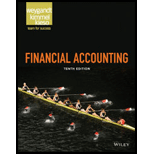
Concept explainers
(a)
The cost of goods available for sale of E Distribution.
(b) (1)
Periodic Inventory System:
Periodic inventory system is a system, in which the inventory is updated in the accounting records on a periodic basis such as at the end of each month, quarter or year. In other words, it is an accounting method which is used to determine the amount of inventory at the end of each accounting period.
First-in-First-Out:
In First-in-First-Out (FIFO) method, the costs of the initially purchased items are considered as cost of goods sold, for the items which are sold first. The value of the ending inventory consists of the recent purchased items.
Last-in-First-Out:
In Last-in-First-Out (LIFO) method, the costs of the last purchased items are considered as the cost of goods sold, for the items which are sold first. The value of the closing stock consists of the initial purchased items.
Moving -average cost method:
Under moving average cost method, the company calculates a new average cost after every purchase is made. It is determined by dividing the cost of goods available for sale by the units on hand.
The ending inventory using the assumed
(2)
Periodic Inventory System:
Periodic inventory system is a system, in which the inventory is updated in the accounting records on a periodic basis such as at the end of each month, quarter or year. In other words, it is an accounting method which is used to determine the amount of inventory at the end of each accounting period.
First-in-First-Out:
In First-in-First-Out (FIFO) method, the costs of the initially purchased items are considered as cost of goods sold, for the items which are sold first. The value of the ending inventory consists of the recent purchased items.
Last-in-First-Out:
In Last-in-First-Out (LIFO) method, the costs of the last purchased items are considered as the cost of goods sold, for the items which are sold first. The value of the closing stock consists of the initial purchased items.
Moving -average cost method:
Under moving average cost method, the company calculates a new average cost after every purchase is made. It is determined by dividing the cost of goods available for sale by the units on hand.
The cost of goods sold under the cash flow methods of FIFO, LIFO, and Average-cost method.
(c) (1)
To identify: The cost flow method which results in the highest inventory amount for the
(2)
To identify: The cost flow method which results in the highest cost of goods sold for the income statement.
Want to see the full answer?
Check out a sample textbook solution
Chapter 6 Solutions
Financial Accounting
- Two parts of this probarrow_forwardthe 5. (P13B.10a in 11th, P15B.7a in 10th) Calculate, by explicit summation, the vibrational partition function and vibrational contribution to the energy of 12 molecules at a 100 K given that its vibrational energy levels lie at the following wavenumbers above the zero-point energy level: 0,213.30, 425.39, 636.27, 845.93 cm 1. What proportion of 12 molecules are in the ground and first two excited levels at this temperature? (Answer: 1.049, 0.953, 0.044, 0.002)arrow_forwardSp25 ACCT X CengageNOWv2 | Online teaching X exhibit 6.4.jpg 71x399) x + bw.com/ilrn/takeAssignment/takeAssignmentMain.do?inprogress=true FIFO perpetual inventory The beginning inventory at Dunne Co. and data on purchases and sales for a three-month period ending June 30 are Number Date Transaction of Units Per Unit Total Apr. 3 Inventory 25 $1,200 $30,000 8 Purchase 75 1,240 93,000 11 Sale 40 2,000 80,000 30 Sale 30 2,000 60,000 May 8 Purchase 60 1,260 75,600 10 Sale 50 2,000 100,000 19 Sale 20 2,000 40,000 < 28 Purchase 80 1,260 100,800 June 5 Sale 40 2,250 90,000 16 Sale 25 2,250 56,250 21 Purchase 35 1,264 44,240 28 Sale 44 2,250 99,000 Required: 1. Record the inventory, purchases, and cost of goods sold data in a perpetual inventory record similar to the one illust first-in, first-out method. Under FIFO, if units are in inventory at two different costs, enter the units with the LOWER un Check My Work 3 more Check My Work uses remaining Q Search hparrow_forward
- PLEASE HELP! NOTICE. THERE ARE FIVE CELLS ON THE LEFT SIDE TO FILL. THE DROPDOWN SHOWS THE OPTIONS FOR THESE CELLS.arrow_forwardCalm Ltd has the following data relating tò two investment projects, only one of which mayb e s e l e c t e d :The cost of capital is 10 per cent, and depreciation is calculated using straight line method.a . Calculate for each of the project:i. Average annual accounting rate of return on average capital investedi i . Net Present Valuei l l . I n t e r n a l R a t e o f Returnb. Discuss the relative merits of the methods of evaluation mentioned above in (a).Q.4a . In the context of process costing, discuss the following concepts briefly, i . Equivalent unitsNormal lossill. Abnormal lossi v. Joint productsV . By productsb . Discuss the different types of standard costing and objectives of standard costing.arrow_forwardPlease help me correct the wrong answers:arrow_forward

 AccountingAccountingISBN:9781337272094Author:WARREN, Carl S., Reeve, James M., Duchac, Jonathan E.Publisher:Cengage Learning,
AccountingAccountingISBN:9781337272094Author:WARREN, Carl S., Reeve, James M., Duchac, Jonathan E.Publisher:Cengage Learning, Accounting Information SystemsAccountingISBN:9781337619202Author:Hall, James A.Publisher:Cengage Learning,
Accounting Information SystemsAccountingISBN:9781337619202Author:Hall, James A.Publisher:Cengage Learning, Horngren's Cost Accounting: A Managerial Emphasis...AccountingISBN:9780134475585Author:Srikant M. Datar, Madhav V. RajanPublisher:PEARSON
Horngren's Cost Accounting: A Managerial Emphasis...AccountingISBN:9780134475585Author:Srikant M. Datar, Madhav V. RajanPublisher:PEARSON Intermediate AccountingAccountingISBN:9781259722660Author:J. David Spiceland, Mark W. Nelson, Wayne M ThomasPublisher:McGraw-Hill Education
Intermediate AccountingAccountingISBN:9781259722660Author:J. David Spiceland, Mark W. Nelson, Wayne M ThomasPublisher:McGraw-Hill Education Financial and Managerial AccountingAccountingISBN:9781259726705Author:John J Wild, Ken W. Shaw, Barbara Chiappetta Fundamental Accounting PrinciplesPublisher:McGraw-Hill Education
Financial and Managerial AccountingAccountingISBN:9781259726705Author:John J Wild, Ken W. Shaw, Barbara Chiappetta Fundamental Accounting PrinciplesPublisher:McGraw-Hill Education





